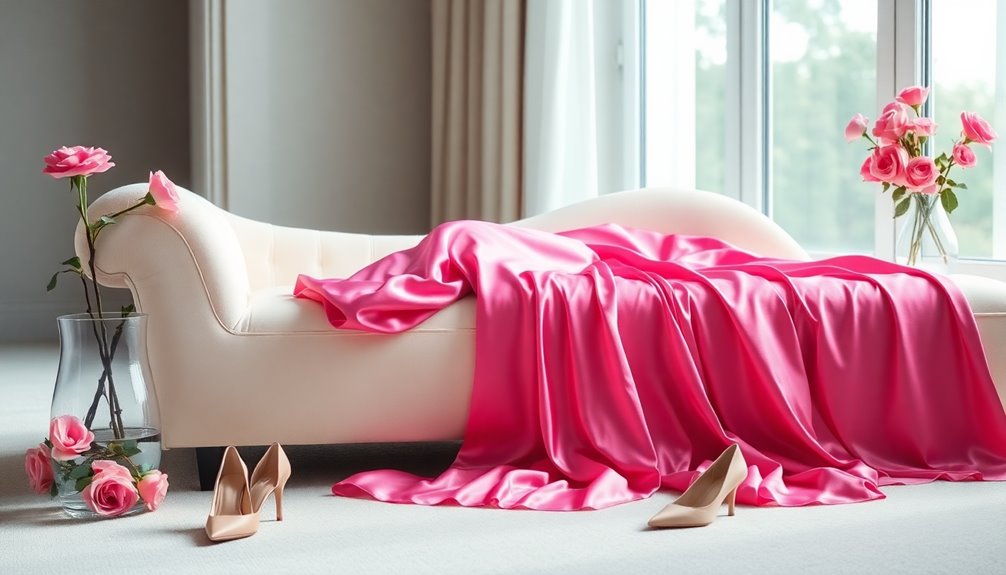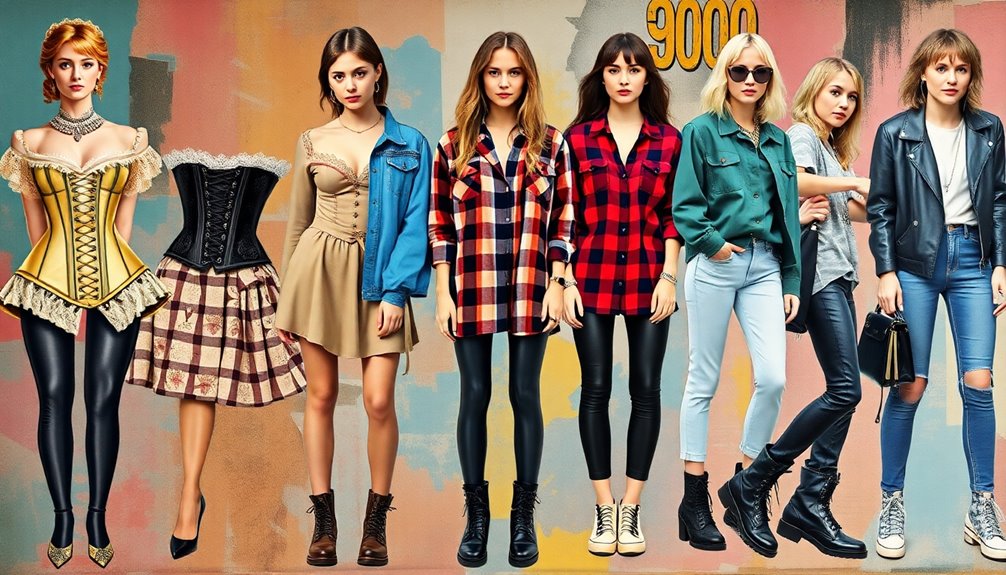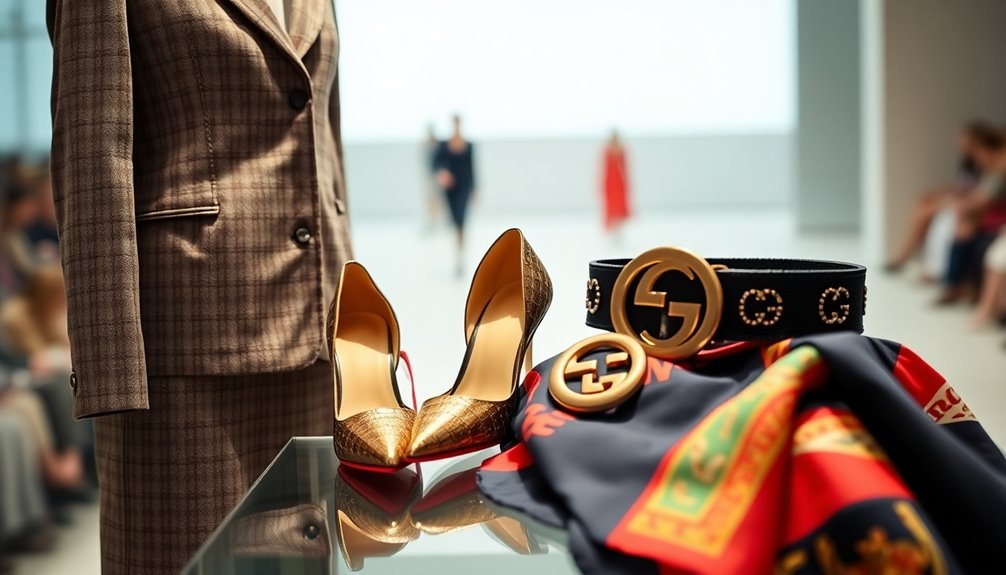Pink's significance in fashion is a captivating blend of history and cultural shifts. It began as a symbol of wealth in the 18th century and evolved through gender associations, with pink often linked to femininity. Designers like Valentino and Rei Kawakubo challenge traditional views, making pink a statement of empowerment and individuality today. In pop culture, movies and music artists use pink to symbolize rebellion and sophistication. Globally, pink signifies different values, from beauty in Japan to hospitality in India. There's so much more to uncover about pink's vibrant role in fashion history.
Key Takeaways
- Pink's historical significance dates back to ancient texts and evolved from a symbol of wealth in the 18th century to a fashion staple.
- Initially gender-neutral, pink's association with femininity solidified in the mid-20th century through marketing and cultural shifts.
- In film and pop culture, pink acts as a powerful symbol for femininity, empowerment, and rebellion, challenging traditional norms.
- Contemporary designers like Rei Kawakubo and Valentino are redefining pink, making it a statement of individuality and inclusivity.
- Cultural interpretations of pink vary globally, representing beauty, hospitality, and trust, transcending traditional gender associations in fashion.
Historical Origins of Pink
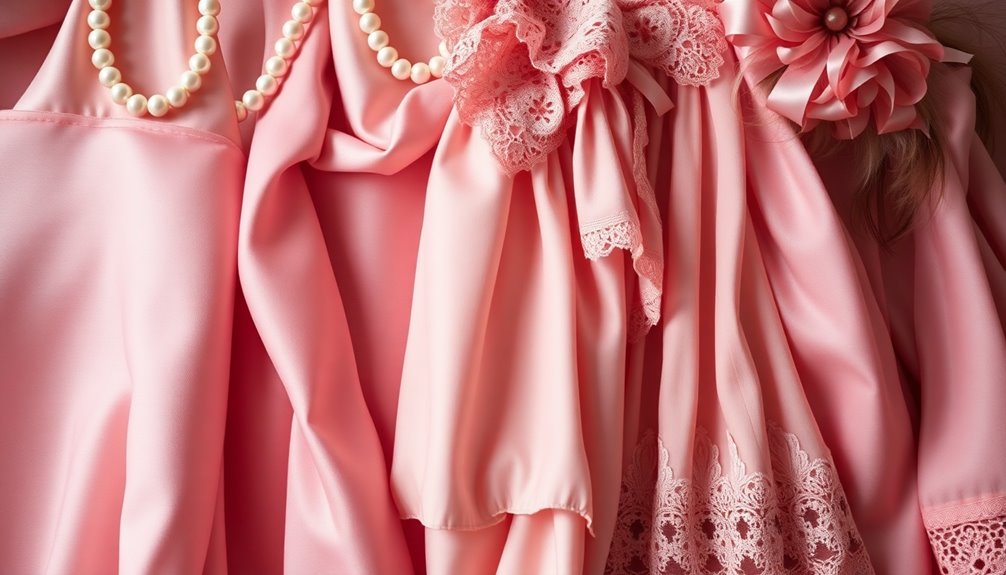
The historical origins of pink reveal a fascinating journey through time and culture. You might be surprised to learn that the concept of pink first emerged in 800 BC within Homer's *Odyssey*.
Roman poets later described it using the Latin term *roseus*, which means "rosy" or "pink." It's even mentioned in Lucretius's *On the Nature of Things* to depict the dawn, famously referred to as "rosy-fingered dawn."
Although pink wasn't prevalent in Middle Ages fashion, it found a place in religious art.
Fast forward to the 18th century, and pink became a symbol of wealth and status, popularized by Madame de Pompadour, Louis XV's mistress. This association with wealth was cemented when a special tint was crafted at the Sèvres porcelain factory for her. This color radiated elegance and aristocratic splendor, worn by both men and women.
In art, pink held significant meaning, often symbolizing innocence or seduction.
In early Renaissance paintings, the Christ child was sometimes depicted in pink, enhancing its spiritual connotations.
Thus, pink's historical journey intertwines deeply with cultural, social, and artistic expressions.
Gendered Evolution of Pink
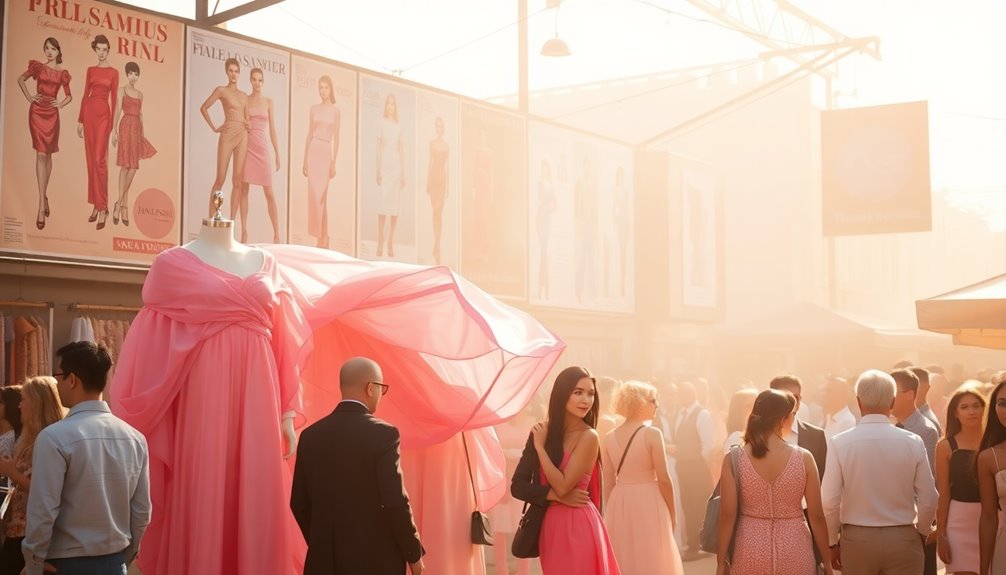
Throughout history, pink's association with gender has undergone significant shifts, reflecting broader societal changes. In the mid-19th century, pink and blue emerged as baby colors, used interchangeably without strict gender definitions. Surprisingly, in the early 20th century, pink was sometimes regarded as more masculine.
However, by the mid-20th century, marketing and cultural influences began to solidify pink as a color for girls and blue for boys. Mamie Eisenhower's fondness for pink in the 1950s played a pivotal role in this trend, as consumer campaigns further entrenched these associations in fashion and decor. This change in perception can be traced back to the historical attribution of color associations that began solidifying in the 1940s.
The feminist movements of the 1960s and 1970s briefly disrupted this gendering, as unisex clothing gained popularity, pushing pink to the sidelines. Feminists argued for more gender-neutral options, rejecting pink as a symbol of traditional femininity.
Yet, by the 1990s, pink's association with girls intensified, especially in toy marketing. Today, pink has been reclaimed by various groups as a symbol of rebellion against gender norms.
Globally, perceptions of pink vary, and modern fashion trends have made it more versatile, allowing you to wear it across different genders and contexts.
Pink in Film and Pop Culture
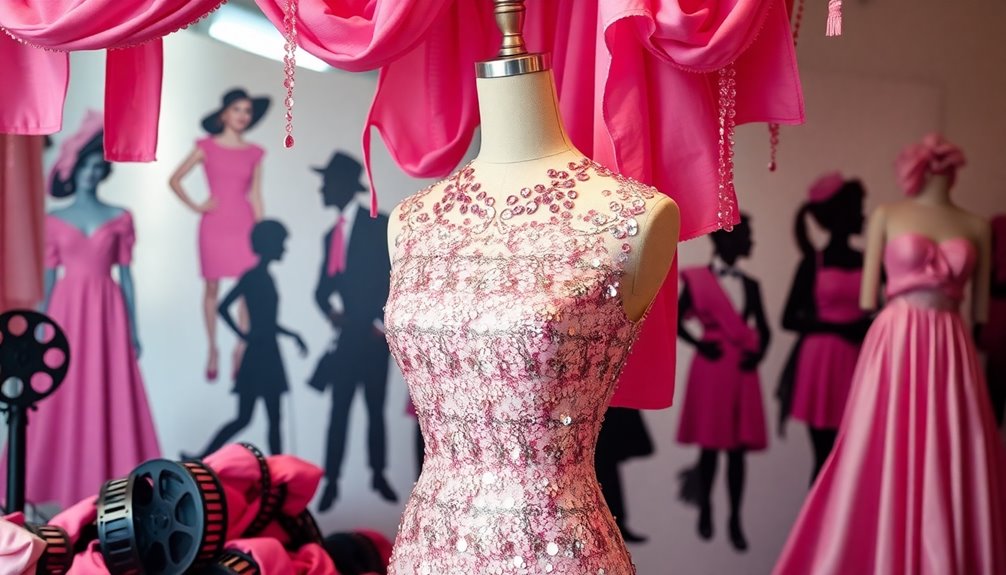
Pink often emerges as a powerful visual cue in film and pop culture, shaping perceptions of femininity and rebellion alike. In *Funny Face*, pink signifies sophistication within the fashion magazine world, encapsulating an idealized femininity. Additionally, the film exemplifies how Technicolor's impact on aesthetics enhances the vibrant portrayal of fashion.
Conversely, *But I'm a Cheerleader* uses pink to critique societal norms around gender, showcasing its duality as both playful and subversive.
*Legally Blonde* flips the script on pink, transforming it into a symbol of empowerment rather than submission. In the recent *Barbie* film, pink embodies defiance against cultural stereotypes, presenting it as a dynamic and fun color.
Beyond film, pink's presence in music reflects a sense of rebellion. Bands like the Sex Pistols and artists like Pnk use pink to challenge norms and promote self-expression.
R&B stars like Rihanna also harness pink to evoke empowerment and positive emotions.
From the character Daphne in *Scooby-Doo* to the protagonists in *Fate: The Winx Saga*, pink often appears, reinforcing its cultural significance.
Ultimately, pink is more than a color; it's a narrative tool that communicates complex themes in both film and pop culture.
Designers Shaping Pink Fashion
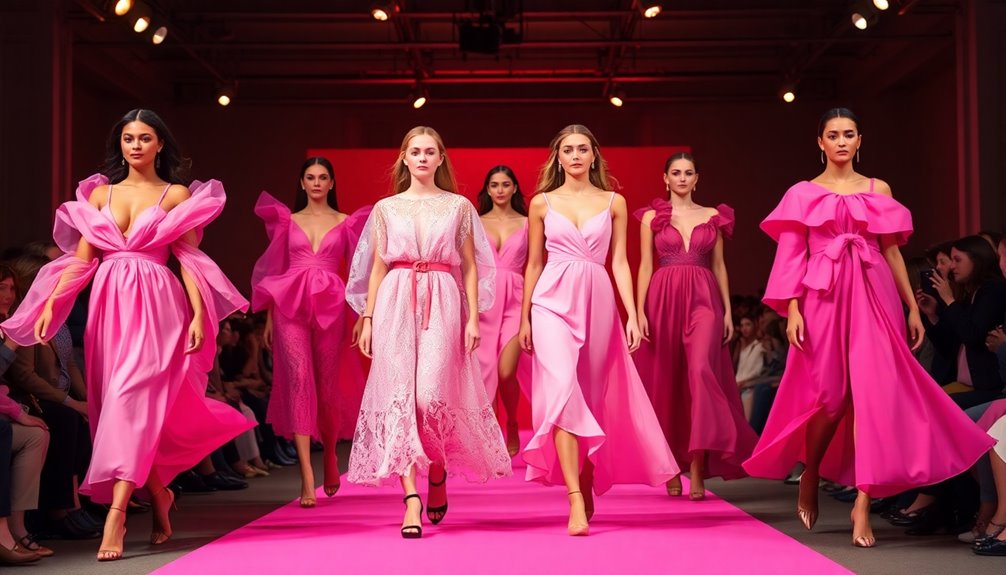
Shaping the narrative around pink fashion, contemporary designers are redefining this vibrant hue beyond its traditional associations. Designers like Rei Kawakubo of Comme des Garçons challenge conventional femininity, presenting pink in avant-garde ways.
Meanwhile, Valentino’s “Pink Is Punk” collection boldly reinterprets the color, asserting its relevance in modern fashion. Historically, pink wasn’t always gender-specific. In the 18th century, it adorned both men and women, and Louis XV-era gowns showcased its luxurious appeal. However, mid-20th century marketing solidified pink as a feminine color. Today, designers aim to return pink to its multifaceted roots, moving beyond outdated stereotypes. Valentino’s “Pink Is Punk” collection challenges these stereotypes by incorporating unexpected elements and bold designs, embracing a more inclusive and diverse portrayal of the color. This reimagining of pink is in line with Valentino’s history of challenging traditional notions of color and fashion, as seen in the iconic history of Valentino red dress, which has become a symbol of empowerment and sophistication. By subverting expectations and exploring the multifaceted roots of pink, Valentino is reshaping the narrative surrounding the color in the world of high fashion.
As we look ahead to the spring/summer 2025 season, powder pink emerges as a key trend, with Erdem, Jason Wu, and Alaïa leading the charge. This color's versatility also extends into men's fashion, proving it can be fresh and playful for all.
With brands like Ferragamo and DKNY regularly incorporating pink into their collections, the color continues to evolve, reflecting a broader cultural shift. Pink's symbolism of love isn't just a color; it's a statement of individuality and inclusivity in fashion.
Cultural Variations of Pink
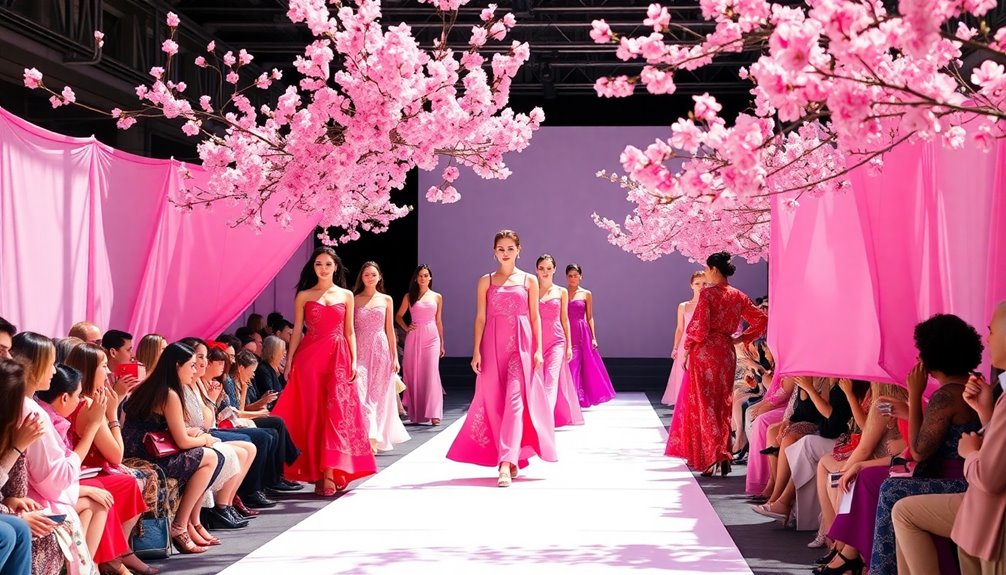
Exploring the cultural variations of pink reveals its rich tapestry of meanings across different societies. In Japan, pink is tied to cherry blossoms, symbolizing beauty and the fleeting nature of life. Wearing pink can even indicate good health, while in contemporary contexts, it can symbolize masculinity and mourning, reflecting young warriors' spirit.
In India, pink represents hospitality and celebration, embraced by both men and women alike. Meanwhile, in Thailand, men don pink at weddings for good luck, and brides often incorporate the color, traditionally wearing pink before shifting to white with pink sashes.
Korea associates pink with trust, innocence, and purity, making it a popular choice for children's clothing. Historically, in the 18th and 19th centuries, pink was viewed as masculine in Western cultures, but by the mid-20th century, it became a symbol of femininity, especially after Mamie Eisenhower's iconic gown. Current trends show a shift away from strict gender-color associations, allowing pink to be embraced by all.
Today, pink's symbolism continues to evolve, transcending traditional gender norms and appearing in political expressions, as seen with the pink pussy hats. This vibrant color remains a dynamic force in both fashion and cultural identity across the globe.
Frequently Asked Questions
What Materials Are Commonly Used to Create Pink Garments?
To create pink garments, you'll often find fabrics like satin, lace, and tulle being used.
These materials lend elegance and softness to your designs.
For dyeing, natural options include hibiscus flowers, beetroot, and rose petals, while synthetic methods might involve Tintex dyes or stovetop hand dyeing.
Each fabric type and dye method can result in various shades of pink, allowing you to customize your creations to suit any occasion.
How Can I Incorporate Pink Into My Wardrobe?
To incorporate pink into your wardrobe, start with simple pieces like a linen baby doll dress or a pink tank dress for casual outings.
Layer with a pink cardigan or mix textures with a pink blouse and denim.
Pair pink with dark tones like black for sophistication, or go bold with red.
Don't forget accessories—impactful jewelry or a chic handbag can elevate your look.
Experiment and have fun with different combinations!
Are There Any Famous Pink Fashion Collections?
Absolutely! You'll find several famous pink fashion collections that have made a lasting impact.
Think of Christian Dior's iconic pink gowns, showcasing femininity and joy.
Elsa Schiaparelli's "Shocking Pink" also stands out as a bold statement in her designs.
Don't forget about pop culture moments, like Marilyn Monroe's dazzling pink dress in "Gentlemen Prefer Blondes."
Each collection reflects different eras and styles, making pink a timeless choice in fashion.
What Skincare Products Leverage Pink in Their Branding?
When you explore skincare products that leverage pink in their branding, you'll find several standouts.
Innisfree's Dewy Glow Jam Cleanser offers a foamy, hydrating experience with cherry blossom extract.
Glow Recipe's Watermelon Glow Pink Juice Moisturizer cools and refreshes your skin.
Essence's Hello, Good Stuff Glow Serum Primer nourishes with watermelon water and niacinamide.
Each product combines effective ingredients with charming pink packaging, making your skincare routine both effective and visually appealing.
How Do Different Cultures Perceive the Color Pink Today?
Different cultures perceive pink in unique ways today.
In Japan, it symbolizes beauty and renewal, while in India, it's linked to hospitality and celebration.
Thailand associates pink with good luck, especially at weddings.
In contrast, Western cultures often tie pink to femininity and childhood.
As cultural exchanges grow, you're likely to see these meanings evolve, reflecting a blend of traditional values and contemporary influences, making pink a rich symbol worldwide.
Conclusion
In fashion, pink isn't just a color; it's a story woven through history, culture, and identity. You've seen how its meaning has evolved, from its historical roots to its bold presence in film and pop culture. Designers continue to reshape its significance, making pink a versatile choice for all. Understanding pink's journey helps you appreciate its power in your wardrobe, allowing you to express yourself with confidence and flair, no matter the occasion.
